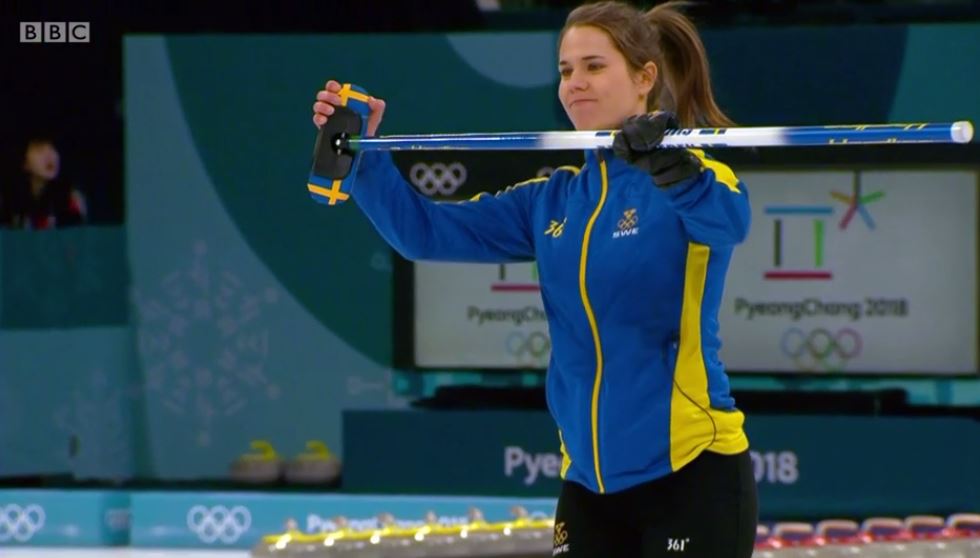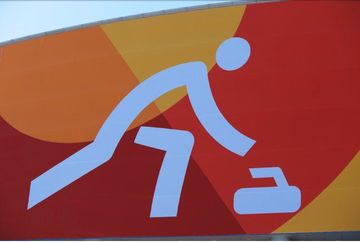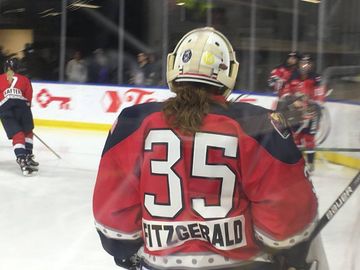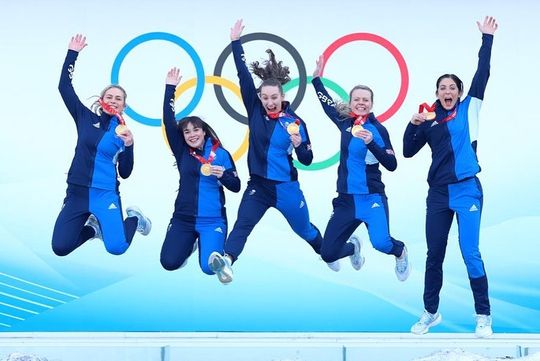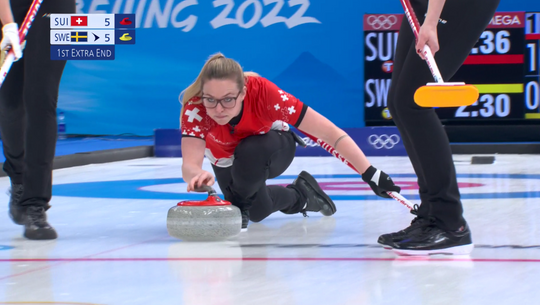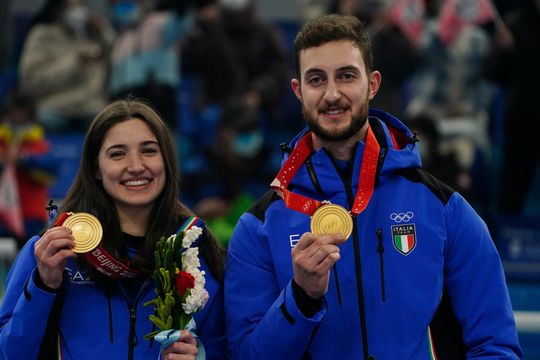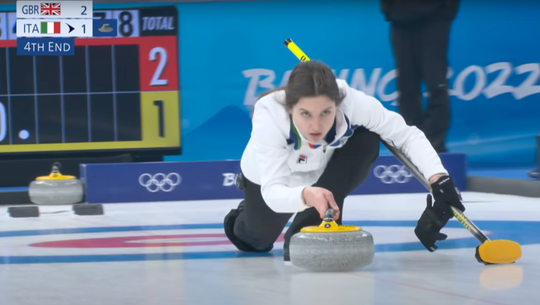Curling fans were treated to two terrific semifinal matchups after a week of great round robin play. The host nation and top seed, Team Korea, faced off against fourth-place Japan. In what might have seemed like a possible gold medal game prior to the tournament, second seed Sweden played third-ranked Great Britain in the other semifinal match.
Just as they've done all tournament, Kim Eun-jung's team got off to the fast start, scoring three in the first end with hammer. After a deuce in five, Korea was well-positioned to advance with a 6-3 lead. Holding Japan to a single in six, Team Korea blanked in seven and scored a single in eight to go up 7-4. Things got dicey for Korea in the ninth though. With a stone straddling the button and the four-foot and another sitting between the eight-foot and the four-foot, Kim Eun-jung attempted a raise to lie three. She was mostly successful, bumping her second stone up so it was completely in the four-foot but her shooter rolled too far and Japan was still third shot.
With her first shot of the end, Japanese skip Satsuki Fujisawa attempted a double take-out. She spilled one of the Korean shot stones to the edge of the 12-foot and grabbed a piece of the button with her shooter. With her second stone, Eun-jung knocked both stones out of the four-foot, but spilled her shooter. Korea still had shot rock, but Japan's stone was second. Under pressure, Fujisawa made a raise to push Korea's red stone back for the deuce.
Still, Korea had hammer coming home and should have been able to close out the victory. Japan had other plans. The end was going well for Korea until Kim Kyeong-ae, Korea's third, missed a clearing attempting, opening the door for Japan. Fujisawa drew with her first shot, grabbing a piece of the button, with Kim Kyeong-ae's missed shooter acting as a guard. Kim Eun-jung tried a takeout with her first shot, but wrecked on the guard. With her final shot of the end, Fujisawa replaced the guard, protecting her shot stone in the rings. With hammer, Korea tried a raise but couldn't drive the yellow stone far enough while spilling the shooter to the edge of the eight-foot. It was a steal of one for Japan and extra ends to decide who would play for the gold medal.
The key shot in the extra end for Korea was from third Kim Kyeong-ae. Facing two Japanese stones in the four-foot, she attempted a double take-out with her final throw. Driving the yellow guard into the rings, it connected with one of the yellow stones in the house, drove it back into the other. Clearing the guard and leaving just one shot stone to deal with, it turned the end in Korea's favor. Fujisawa countered with a guard with her first shot, but it was too high and allowed Kim Eun-jung to come around the guard and play a raise on Japan's shot stone that had a piece of the button. The raise was successful and pushed the yellow stone to the 12-foot. Korea was sitting tow in the four-foot.
Japan played a raise and pushed the red shot stone to the eight-foot behind the tee line, with the shooter rolling into the four-foot but, crucially, not buried. Korea opted to draw for one grabbed a piece of the button for the point, victory, and trip to the gold medal match.
I was excited for the Great Britain vs. Sweden semifinal because I thought this might be Eve Muirhead's moment. Team GB was the most experienced of the playoff teams. I believed Muirhead's previous Olympic experience from a bronze medal win in Sochi, combined with some strong individual play from her team, would give her an edge. Unfortunately for Great Britain, that's not how things played out. Things were close for the first half of the game, with GB and Sweden trading points and entering the break tied at 3. Sweden got its deuce with hammer in six. The turning point came in the next end, when Sweden stole 3. The errors compounded for GB in the seventh, with second Vicki Adams missing a crucial double take-out. Third Anna Sloan followed, but missed her take-out attempt on her first throw. Sloan made up for the mistake with her second shot, a hit and roll to the button that was partially buried.
A rare miss from Swedish skip Anna Hasselborg presented Muirhead with an opportunity to turn the end around, but her draw with her first stone didn't grab enough of the button and left a double for Hasselborg. The Swedish skip made the double with her final shot to sit three. Muirhead attempted a draw with her final throw, but she wrecked on a guard.
The miss was representative of Muirhead's game. Uncharacteristically she struggled, curling just a 69% to Hasselborg's 83%. Her team, while outcurled by Sweden, actually had a decent game; Sloan curled at 74%, Adams at 81%, and Lauren Gray at 88%. In the past, Muirhead has been let down by poor performance by her teammates, but in these playoffs Muirhead's play was what disappointed.
The match was not without (a minor) controversy. In the second end, Sloan burned a stone while sweeping. She told Hasselborg who removed the burned stone after a short discussion with Team GB's third. While the situation differed slightly from the Canada-Denmark match (there was a very brief discussion between the players involved) Hasselborg's decision to remove the stone (despite it not changing the outcome of the shot considerably) was not subject to two days of debate and consternation. Perhaps the earlier anger in the press at Canadian skip Rachel Homan had less to do with curling etiquette than we were led to believe, and more to do with perceptions of Homan.
Muirhead's struggles continued in the bronze medal match. GB and Japan traded singles through the first five ends, with the Scots leading 3-2 at the break. Japan blanked the sixth and seventh ends before tying things up with one in the eighth. Japan recorded a crucial steal in nine to sit one up going into the tenth. With hammer and needing one to tie and two to win, I expected Muirhead to at least push it to extras. But with the shot there for two, Muirhead's final stone was both heavy and wide, giving Japan the bronze medal. Muirhead struggled again, curling at just 65%, but her teammates played significantly better.
For their part, Team Japan was fully deserving of the bronze medal. Japan's back end was excellent; third Chinami Yoshida curled at 85% and skip Satsuki Fujisawa curled at 83%. It still has to be disappointing for Muirhead and Team GB, not only did they not make the final, but they couldn't replicate their success from Sochi.
Both Korea and Sweden deserved to play for gold. They were the two best performers of the tournament. However, the final wasn't a classic -- more of a slow motion blowout. Korea didn't play badly (as a team they curled 81%) but skip Kim Eun-jung had a few near misses and Sweden capitalized. Korea was held to a single in one and Sweden blanked the second. Hasselborg's team got their deuce in three and then stole singles in ends four and five to lead 4-1 at the break.
The game was over in the seventh, when Sweden scored 3, the first big end Korea surrendered all tournament. Hasselborg needed a draw to the eight-foot and a take-out with her skip stones to net three points. The teams played two more ends, but it was handshakes after the ninth.
Sweden was simply dominant in the final and fully deserved its third gold medal in women's curling. Lead Sofia Mabergs curled a perfect game and second Agnes Knochenhauer curled at 83%. Sweden's back end was simply marvelous; Sara McManus curled at 90% and Hasselborg curled at 94%. That is exceptional curling, and few teams could have matched them.
My team of the tournament includes Team USA's Becca Hamilton at lead. Hamilton curled the most of any woman at Pyeongchang, competing in both the mixed doubles tournament and the women's competition. I cannot stress enough how physically demanding and tiring this was for Hamilton. She curled 16 games in two weeks; that just doesn't happen at this level. What's more, she curled well. While you can't quite compare numbers from the mixed game and the four-person game, taken together she curled at 79% in 16 games. After a sometimes rocky mixed tournament, she improved her play in the women's tournament, curling at 85% for second among leads.
It's tempting to named Knochenauer as the second, and she's more than deserving, but I want to highlight the play of Galina Arsenkina with the Olympic athletes from Russia. While Aleksander Krushelnitckii's positive banned substance test rocked the curling world and resulted in OAR losing its bronze medal from that competition, Arsenkina stayed focused for her team, curling at 82% (second behind Knochenauer) on a dismal OAR women's squad that finished 2-7. (I would also like to point out that Aleksander Krushelnitckii was hands-down the worst of all 16 players in round robin play in the mixed doubles competition and for whatever reason pretty much everyone covering this story neglected to mention this.)
At third it simply has to be Sweden's Sara McManus. She was dominant and consistent from start to finish. Only Emma Miskew came close to matching her performance, but McManus' dominance under pressure in the playoff rounds cannot be overlooked. She had a phenomenal Games.
I wanted to name Korea's Kim Eun-jung my skip of the tournament. She made numerous clutch shots on the way to an unexpected silver medal and was second among players at her position. But ultimately this selection must go to Sweden's Anna Hasselborg, whose dominance cannot be ignored. She led all skips by curling at 82% during round robin play and then curled at 89% in the playoffs. She was phenomenal.
If you're new to curling and want to learn more about it (or learn to play!), check out a curling club near you.
- Find a Club in the USA
- Find a Club in Canada
- Find a Club in the UK
- Complete list of Curling Federations
(Photo: BBC Sport/Twitter)
